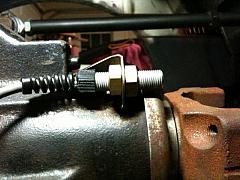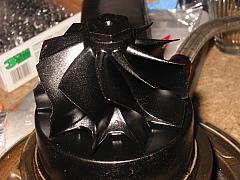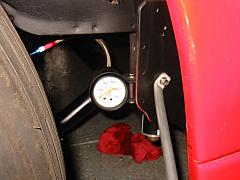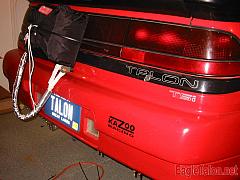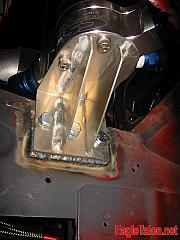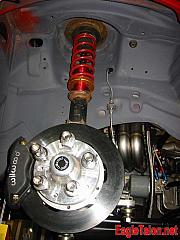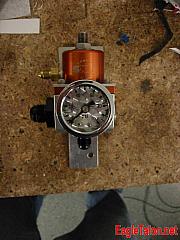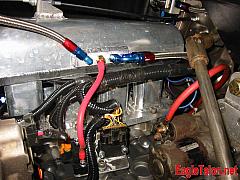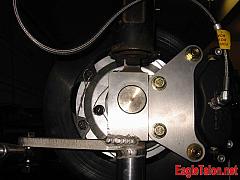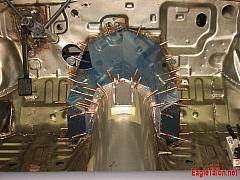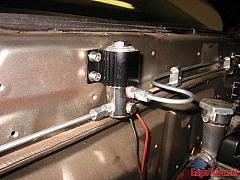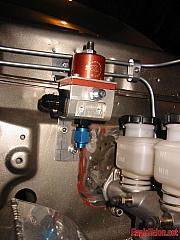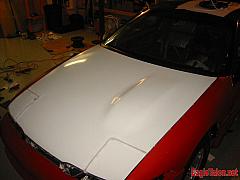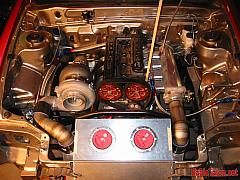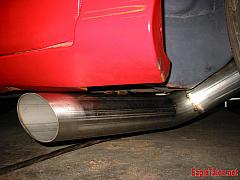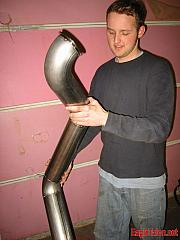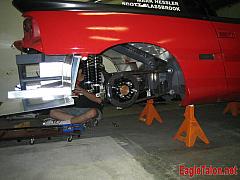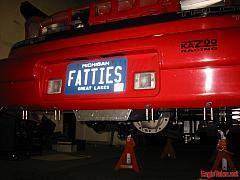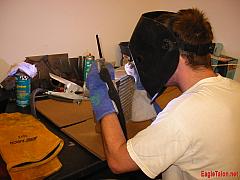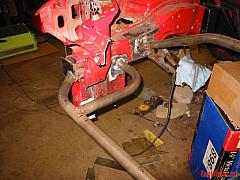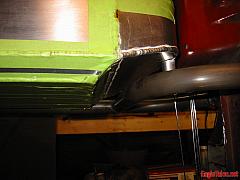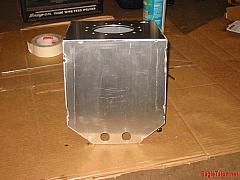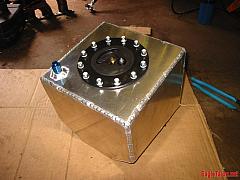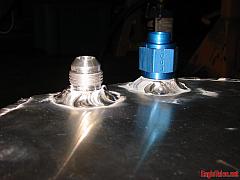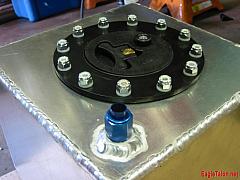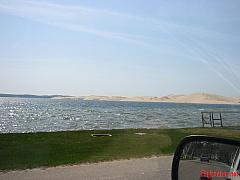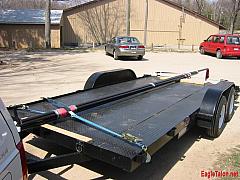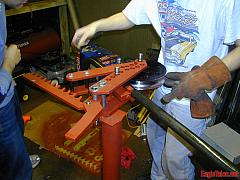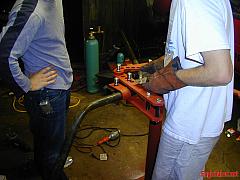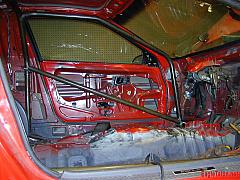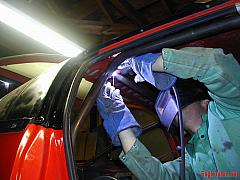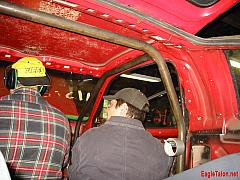It Lives!
05/27/07 – It’s about damn time!
Over the past week, I can’t tell you how many small little updates, completions, fixes, and everything else that I’ve done to the car – It’s been quite insane. We’ve finished up the turbo mounting; fabbed up oil pickup tubes; painted things here and there; installed new parts; removed parts from the car; reinstalled parts again; modified everything; finished up details; puked oil, water, ATF and Gear oil on the ground; checked wiring; added pull-up resistors here and there; and the end result is this (An amazingly long post follows the video) :
So, this post needs quite a bit of explanation. Or, I should say that I *want* to explain more of it 🙂 Last Sunday, the car started. It was around 5pm. In order to get that to happen, I had spent the previous week and a half getting things done after work, and on the previous weekend. Generally, I would work until around 11pm. It was quite an accomplishment. The sheer number of things done on the car, however small, all still had to happen before it could run.
So, flashback to a few weeks ago. After getting the dash fabricated, welded up, fitted, sanded, painted, and to the point where I called it “done”, it was time to take it all back apart. I had to replace the Sport Comp fuel pressure gauge with a new phantom gauge so that they all looked identical – all except the AEM UEGO. After that, there was a fair amount of work to get all the plumbing done – all the plumbing on the car is AN, including the vacuum lines if you haven’t already noticed. So, it was kind of a clusterf*ck to get that all worked out. I also needed to get a fuel pressure isolator, and I was looking for one compatible with alcohol, in case I decide to run methanol, ethanol, or e85 in the future. And, for what it’s worth, you generally can’t find them. Malory makes one of them – it’s about $65. So I get the plumbing knocked out, and what’s next?
The gauge wiring harness. This thing was actually a lot more complicated than I thought it was going to be. The gauge harness actually a series of four harnesses: one for the AEM UEGO that connects to the o2 sensor, one for the lights (+12V switched on the switch panel,) one for the Tachometer & water temp gauge, and one for power to the AEM UEGO gauge and the EGT gauge. So, Why did I essentially make three harnesses? Well, the gauges need to be able to be *removed* from the dash, and without splitting the harness up, I would never be able to take the damn thing apart. The EGT gauge and the Tachometer have permanent wires coming out of the back of them, so they were good candidates for a base harness. the UEGO gauge has two connectors on the back of it – one with 6 wires going to the o2 sensor, and the other with four wires: power, ground, o-5V out and serial out. I ran the 0-5V out to the Haltech’s o2 input, so that I would be able to log voltage on the Haltech. Anyway, I took the UEGO’s power side harness, and merged it with the EGT harness, and used a 6 pin metripack connector to get all of those bundled into one harness. The other harness was similarly bundled: The water temp gauge has three spade connectors on the back of it, power, ground, and temperature sender. These were bundled with the Tachometer which also has permanently affixed wiring. to differentiate these, I used a 5 pin metripack connector. the last bundle was the lighting, and fortunately all the lighting is removable from the gauges that I have, so the lighting circuit was a much simpler circuit than it could have been 😮 Anyway, while doing that, I had remembered that I had no TACH signal, so I would have to run one from the factory power transistor back into the car to the gauge cluster. That was a pain to do, but only because it was time consuming. so yeah, no big deal, right? 😉
Next up on the list was hooking up the Fuel pump. I’m using an Aeromotive A1000 pump, but it hadn’t yet been wired in the back of the car. So, I broke out some connectors and wired it up to the battery shutoff switch. It was one of the simplest pieces of wiring on the car 🙂 The pump is controlled through ground by the Haltech, and because I wanted to have some control over it, I ran a switched +12V signal to it. So, the Haltech has to be on and want to control it, and I have to allow the Haltech to control it. If I don’t, then computers may take over the world and all hell will break loose. In addition, the “rear wiring harness” (as I call it) also has a circuit for the lighting that runs to the center brake light in the wing. This will allow me to race at night 🙂
After the fuel pump was done, I started on the oil pump pickup. I already had a version that I was going to use, but it needed some adjustments because I had created it before deciding to go with a kiggly racing girdle on the car. After deciding to use the girdle, I had to shave the supports off of the pickup tube and remake them. So, Monday night rolled around and I pulled an old greasy block out of the shop. I threw it up on the engine stand, pulled it all apart, and fabbed up the brackets for the oil pickup tube.
Tuesday night rolled around, and now it was time to get the oilpan installed. I put the newly fabbed oil pickup tube on the car, and then test fitted the oilpan on the greasy engine-stand 4g63. Everything was set. So, I RTV’d the new oilpan and the engine block. And then all hell broke loose. First, the stock pan bolts were too short to fit with the new oilpan’s flange, which is significantly thicker than a stock flange. No big deal, I have other bolts. So, I break them out and start bolting the oilpan to the car. Except I can’t bolt all the damn bolts to the car – some of the holes in the pan won’t lineup. Crap. Okay, now I have about 16 out of the 20 bolt holes all lines up, but I cannot get the holes on the front and back of the back to lineup, and I have to be careful because they bolt into aluminum 😮 So, I had to take the pan back off and cleanup *all* the RTV – off both the pan and the block. Then, I had to ream the oil pan bolt holes just slightly to get them to allow me to bolt them all up. But, it all bolted up to the mockup! Tolerances are a bitch sometimes. Anyway, got the holes reamed, and then did a complete test fit on the block under the car. All in all, I removed and replaced somewhere between sixty and eighty M6 cap head screws that night – not fun!
Wednesday rolled around and it was now time to get all the cooling system tightened and squared away. I started on the coolant neck – I pulled it off the car, made a restrictor plate to put between the head and neck, and then got all that RTV’d together. After that, I removed all the 12AN lines, and lubricated them before going through and getting them all tightened up. It wasn’t hard, but it was time consuming. After I was done with that, I pretty much called it a night, I think. If I didn’t, I just did other random stuff ;-p Oh, yeah, I ported the oil filter housing.
Thursday was my wife’s birthday. You can’t work on the project on your wife’s birthday.
Friday was a day of complete random stuff. I don’t know what I did, but I spent most of it working. I think I finally got the turbo support bracket mounted to the car, among everything else. I also worked on the Haltech software on Friday, and found out something I didn’t want to know. The E6S, which is an older Haltech model, requires pullup resistors on the Ign Out and the Aux out 1 in order to be used with the stock power transistor units. I didn’t have these resistors in the car. Okay, to clarify, I didn’t *know* that these were required – the manual says nothing about them – but I found information that said that they were.
Saturday morning I spent the day running around – I went out and got a belt for the Alternator, new bolts for the oilpan that were 8mm longer (to allow room for lock washers,) and a few other things. Friday night I had already picked up oil, ATF, gear oil, a filter, distilled water, and some other things. By the time I got back, it was past 2:00, and Mark still wasn’t at the house. He finally got there, and we spent the rest of the night getting more stuff buttoned up. I replaced the oilpan bolts, and then we pulled apart the exhaust side of the engine apart. We had to reassemble it with gaskets. then, we put the flywheel on the car, which is an event in itself. We ended up working until about 10:30pm, and called it a night.
Sunday morning Mark got to the house around 11:00. I started working on the final maps for the Talon while Mark ate breakfast, and then we got to work. We started the day by getting the oil system all squared away – I put oil in the Talon, changed the oil filter, and pulled the timing belt off the car to prime the system. About 10 second into priming, oil started leaking out of the head where the stock oil feed bolt to the turbo goes. Oh crap – I completely forgot about that. So, Mark cut and fabbed up a bolt for me because we didn’t have anything short enough. It didn’t make too much of a mess, thankfully. Oil bolt plug in, we could now move on to the cooling system.
As I filling the cooling system, I started to go over all the connections in the system. Unfortunately, I forgot about two of them in the CSR water pump. The pump has two inlets and two outlets – I’m only using one of each. Because of that, I didn’t tighten the two plugs in the unused inlet and outlet. I discovered this when water started pouring out of the pump. Oops. Unfortunately, the plugs needed a 3/8″ hex wrench to tighen them, and I didn’t have one. I did, however, have a 3/8″ nut that I welded onto a bolt, and used that to tighten the whole mess. After that, the system was sealed 🙂 Sealed so well, in fact, that we couldn’t get an air bubble out of it 🙁 Damn! the not-so-quick fix we came to was simple. We jacked the front of the car up, pulled the jackstands out from underneath it, and lowered the front end of the car down to the ground. This gave us just movement of the cooling system to release the air bubble, and allow water to get to the water pump. Once we did that, I had to add the rest of almost two gallons of water. At this point, I have no clue how large the cooling system is, because I can’t tell you how much water we sopped up off the floor. I imagine it’s around a gallon and a half. Anyway, good riddance! That took *forever* to get done. Next on the list?
The Powerglide. The powerglide in the Talon is from Dave Buschur. I bought it off him back when he sold his tube car. So, it’s filled with previously used fluid. Getting the PG in the car was a pain, too. it’s difficult to lift, and I honestly should have just lifted the car up on the jackstands more than I did to get it in the car. Instead, I tried to lift it up while standing in the car. This was a mistake. I tilted the PG, and about 3 seconds later, ATF came pouring out the back of the transmission, all over the floor and under my shows. Argh. So, we cleaned that up (that’s three of three fluids on the floor for those of you who are counting) and then managed to get the PG in the car. Thankfully, I spent adequate time making sure that I didn’t get ATF all over the interior of the car.
While installing the PG, Rick showed up to lend a hand. I immediately put him on the laptop to check out the maps, and to compare them to a base map that I found. He spent the majority of the time working on that, but lent a hand when we needed tools or rags 🙂
After the PG was installed, I continued working under the car by getting the transmission crossmember bolted in and getting the driveshaft installed. While I was doing this, Mark started filling the rear differential with gear oil. Right around this point, the fact that I only had a small set of hex wrenches bit us again. This time, Mark couldn’t get the fill plug out of the moser diff cover. So, he started fixing this issue by sanding down a 10mm nut, so that he’d be able to weld that to a bolt and be able to extract the plug using the method in which I installed the water pump plugs. Unfortunately, after welding that up for him, he broke it. Inside the diff plug! Argh! And, to make matters worse, he wasn’t able to get the nut out of the diff – it was completely smooth, and there was a ridge in the diff plug so he couldn’t get it out by any means 🙁 So, I took my time under the car with a piece of tig filler rod and the mig welder. I mig’d the filler rod to the broken nut, and extracted it carefully. Mark got it really really stuck, and it was very hard to get it back out, but I was thankful that we didn’t make too big a mess. At that point, it was time to run up to the store and buy a proper hex wrench set. $8.99 solved that problem. I came back from the store, and filled the rear diff with fluid. It’s *large* – I put 2.5 quarts of cheap 70w140 into the rear diff. I used cheap fluid because the differential needs a break-in, and then I will drain and recycle the old fluid, and put some quality fluid in it’s place to replace it.
Ahh… Okay, now what? It was time to install the fuel system. This, fortunately, went without a hitch! How it that even possible? It’s not. Upon turning on the fuel system, I found that one of the lines that was previously tested was leaking. You don’t want fuel leaks in general, but because it was just weeping, we decided that we’d let it slide and fire the car anyway.
So, we verified that the fuel pump worked, the water pump worked, along with the fan. We then made sure the Haltech had the correct settings, and then plugged in the power transistors for the coils and the cam angle sensor. Then, we tried to fire it. It didn’t fire. We quickly discovered that the injectors were working by using a spare CAS to simulated the engine cranking. The Haltech saw RPM, so we knew that coils were the only issue. Right here, I remembered that the Haltech needed 1000ohm 1/4 watt resistors. Mark wanted me to show him the ignition schematic, so I whipped it up on paper for him. It would be a crime for me to get amnesia 😉 Anyway, After I whipped it up, I grabbed a handful of resistors, and went soldering away. Sure enough, the car fired right up. But, it was only running on two cylinders. Okay… a quick wire check showed that I inadvertently wired the aux out 1 (the second coil trigger in this case) to the ground – I added a pull-down resistor instead of a pull-up resistor. I soldered a new resistor in place, and we fired it back up.
I would have loved to talk about how we got the map spot-fricking on and it purred like a kitten, but the fact of the matter is that wasn’t what happened. There was surge, and some sputtering at times, but nothing that we can’t tune. And actually, the car does start right up, but stumbles for a few seconds because I have to mess with the post start map – after about 10 second, it actually does run very well for just eyeballing a map out of it. It will get a whole lot better with one or two tuning sessions, but I didn’t want to make any of the neighbors angry 😉

